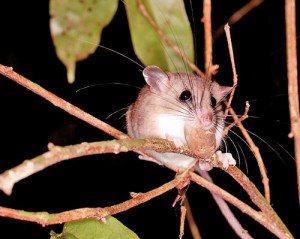This little rat may make big news
Though well surveyed for its flora and fauna, Sri Lanka still holds a lot of mysteries in natural history. In recent years Sri Lankan naturalists have continued to uncover the secrets of our wilds. Some of the finds are new to science, and some are new records for the country. Among fauna they have been mostly of amphibians, reptiles, insects and birds. The mammals of Sri Lanka are a well studied subject. But we realize how much there is still to know when we encounter a mystery mammal, when experts cannot identify its species using existing knowledge or local data.

Uditha Hettige’s pic of the mystery rodent
On January 12, 2015, I came across such a species in the Makandava Forest Reserve (popularly known as the Kithulgala forest). During an exploration I found a mouse which I determined did not match the description of any rodents that I have known through previous experience. Realizing it was something very unusual and important, I then showed it to a group of mammal enthusiasts I was guiding, including the renowned Canadian mammalogist Fiona Reid, author of several field guides on mammals of North and South America, and a number of research papers.
It was a mouse slightly smaller than the Black (or House) Rat (Ratus ratus) and much larger than the House Mouse (Mus musculus). The head and body length, as estimated by us, was about 12-13 cm. It had brown upperparts and its underparts were white, the colours separated with high contrast. It had a dark, semi-prehensile, penicillated (i.e., having a tuft of fine hairs) tail. Initially I thought it could be a Sri Lanka Bi-coloured Rat (Srilankamys ohiensis) or White-tailed Wood Rat (Madromys blanfordii) but on closer observation it did not look like either of them.
Fiona and I both agreed that it is not a Mus species (Mus is a genus of small mouse species in Sri Lanka). We were lucky to observe it as close as 3-4 feet from our heads, on a branch, and to have prolonged views. Since we did not have a research permit to catch such wild fauna we could not obtain its body measurements. This is the key component in identifying these small mammals. But we managed to take good photographs. Both Fiona and I agreed that we needed to refer to the literature in order to identify it. Later, looking up the literature available with me on that tour we still could not identify this rodent with certainty.
Still later on studying it further, I could rule out all the similar rodent species in Sri Lanka because of some characteristic difference in each comparison. All the Mus and Vandeleuria species (small mouse species) were excluded due to size and body shape. Size of ears in relation to body, body length and the long, thin mono-coloured penicillated tail rule out other possibilities such as Black Rat, Sri Lanka Bi-coloured Rat and White-tailed Wood Rat.
After her return to Canada and further study, Fiona suggested to me that externally it closely resembles the Indomalayan Pencil-tailed Tree Mouse (Chiropodomys gliroides), a species which is not known to occur in Sri Lanka. But we do not have enough data to make that identification. If this mystery rodent will prove indeed to be that species after further studies, then this will be a huge extension from the range where it is currently known to occur. The geography and distance between that range and Sri Lanka act as a significant ecological barrier. It may be that this Sri Lankan tree mouse was separated away ancestrally a very long time ago and has evolved into a different species. In this case it will be a new species.
I have now been able to resume the study of this rodent for concluding its species identification and have launched a project for field studies to find out more data on its occurrence in this country.


